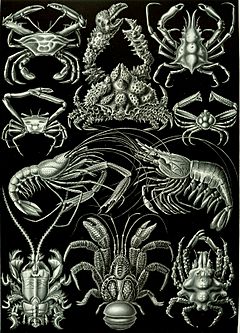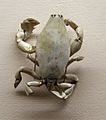Decapod facts for kids
Quick facts for kids Decapoda |
|
|---|---|
 |
|
| "Decapoda" from Ernst Haeckel's Artforms of Nature, 1904 | |
| Scientific classification | |
| Kingdom: | |
| Phylum: | |
| Subphylum: | |
| Class: | |
| Superorder: |
Eucarida
|
| Order: |
Decapoda
Latreille, 1802
|
| Suborders | |
|
Dendrobranchiata |
|
Decapoda is a group of amazing crustaceans. The name "Decapoda" means "ten feet," which is a perfect description for these animals! This group includes many creatures you might know, like crayfish, crabs, lobsters, prawns, and shrimp.
Many decapods are scavengers. This means they help keep the environment clean by eating dead plants and animals. For example, crabs eat a mix of things, including algae and shellfish like molluscs. Lobsters usually hunt and eat live prey.
Contents
What Are Decapods?
Decapods are a type of Arthropoda, which is a big group of animals with exoskeletons (hard outer shells) and jointed legs. They belong to the class called Malacostraca. This class also includes other cool crustaceans like krill and mantis shrimp.
Body Parts of a Decapod
All decapods have ten appendages, or limbs, as their name suggests. Let's explore their unique body structure!
Walking Legs and Claws
The last five pairs of legs are found on the front part of their body. This front part is called the cephalothorax, which is a fancy word for a head and chest combined. These legs are mainly used for walking around.
Many decapods have big, strong pinching claws on their front pair of legs. These claws are called chelae. So, the legs that carry these claws are known as chelipeds. Imagine having a built-in tool for grabbing and crushing!
Mouthparts and Tail
The first three pairs of appendages on the cephalothorax are smaller. They act like jaws and are called maxillipeds. These help the decapod grab and chew its food.
On the abdomen (the back part of the body), decapods have swimming legs called pleopods. These help them move through the water. The very end of their body has a special tail fan, which helps them swim quickly backwards to escape danger.
How Decapods Are Grouped
Scientists classify decapods into different groups based on things like their gills and legs. They also look at how their larvae (baby forms) grow and develop.
There are two main suborders of Decapoda:
- Dendrobranchiata
- Pleocyemata
Dendrobranchiata: The Prawns
This group includes all the true prawns. Many animals that people call "shrimp," like the Atlantic white shrimp, are actually part of this group.
Pleocyemata: True Shrimp, Crabs, and Lobsters
The other large group is the Pleocyemata. This suborder includes a wide variety of decapods.
- Caridea are what we call true shrimp.
- Achelata includes interesting creatures like spiny lobsters, slipper lobsters, and furry lobsters.
- Astacidea contains the familiar lobsters and crayfish.
- Anomura is a diverse group. It includes squat lobsters and the clever hermit crabs, which live in discarded shells.
- Brachyura is the group for all true crabs.
Scientists are always learning more about these animals. They use new studies, including looking at their molecules, to understand how they are related.
Images for kids
-
Whiteleg shrimp, Litopenaeus vannamei (actually a prawn)
-
Spotted cleaner shrimp, Periclimenes yucatanicus
-
California spiny lobster, Panulirus interruptus
-
Blue crab, Callinectes sapidus
See also
 In Spanish: Decápodos para niños
In Spanish: Decápodos para niños






